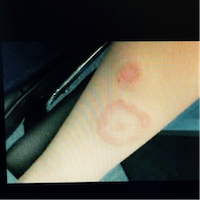Diagnose this Patient's Rash
A 50-year-old forest ranger noted this rash, which he thinks has been present for several weeks. He noticed a similar rash on his dog. It is itchy, with a raised red border and a clear center. It may have increased in size slightly over several weeks. He is otherwise asymptomatic. What is the next step in treating him?

A 50-year-old forest ranger noted this rash, which he thinks has been present for several weeks. He noticed a similar rash on his dog. It is itchy, with a raised red border and a clear center. It may have increased in size slightly over several weeks. He is otherwise asymptomatic.
What is the next step in treating him?
1. Send for a Lyme antibody test
2. Begin doxycycline 100 mg BID for 2 to 4 weeks
3. Do a KOH stain of the shavings from the edge of the rash
4. Watchful waiting in hopes it will resolve
5. Betamethasone cream BID.
The rash pictured is round with a clear center. It has raised borders, is itchy and has been present at least several weeks without change. While it looks like it could be Lyme disease, several features are not consistent.
The typical rash of Lyme Disease of ECM (Erythema Chronica Migrans) usually does not itch or cause pain. It tends to be flat rather than have raised edges. It can spread over the course of weeks, or migrate outward while the center clears. It is often, but not always, associated with systemic symptoms.
The right answer is to do a KOH stain looking for fungal elements.
